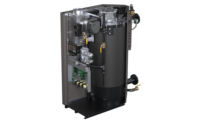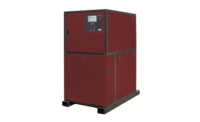As the cost of electricity continues to rise, pulse combustion technology from Fulton, a global manufacturer of steam, hydronic, and thermal fluid heat transfer products, is earning a second and a third look from building owners and facility managers seeking energy efficient solutions to their increasingly more expensive heating needs. That’s because Fulton’s Pulse combustion condensing hydronic boilers feature the lowest electric consumption in the industry.
The Pulse combustion process transfers more heat per square inch than traditional burners. The process is naturally aspirated and does not require a blower motor for operation. An assist fan is used for pre/post purge only and turns off once combustion has been established. In fact, Pulse boilers require electricity only for purge cycles, powering fuel valves, controls and other safety features. The Pulse combustion process itself requires absolutely no electricity.
As a result, the Pulse hydronic heating boiler (2.0 MM BTU/hr input) consumes just 0.75 amps of electricity during run mode and costs less than $0.15 to operate for 10 hours (based on $0.17/kWh electric rate). A comparably sized boiler with a two-horsepower combustion blower motor and power burner will cost more than $15 to operate for 10 hours. During a 2,000-hour heating season, these efficiencies translate to a dramatic comparison of operating costs -- $30 for the Pulse boiler compared to $3,000 for the power burner/blower style boiler.
“Savings like these are difficult to ignore,” said Erin Sperry, commercial heating product manager, Fulton. “When you add the environmental benefits that combustion technology delivers, the choice of a Pulse boiler makes even more sense, both economically and environmentally.”
Because combustion technology requires less electricity, the use of Pulse boilers reduces the amount of energy required to produce electricity at power plants – often three times the amount of energy available to the end user. Lower electricity requirements also means Pulse boilers result in fewer emissions associated with the production of electricity.
“And because the electricity consumption of Pulse boilers is so low, it is very easy to integrate the units into various green building applications, including those that use solar, wind or other alternative sources of energy,” continued Sperry. “Pulse boilers feature the lowest net energy usage, most flexible venting options and simplified system installation requirements, making them ideal for installation in USGBC’s LEED® Certified buildings, and they contribute to other green initiatives.”
Pulse condensing hydronic boilers from Fulton are available in models that range from 300,000 to 2.0 MMBtuh input. The boilers are configured to meet low emission requirements, and a modulation control system provides precise temperature control with infinite turndown capabilities throughout the entire firing rate range. As an added benefit, Fulton’s Pulse boilers have no moving parts, contributing to the lowest maintenance cost of any commercial boiler in the industry.





